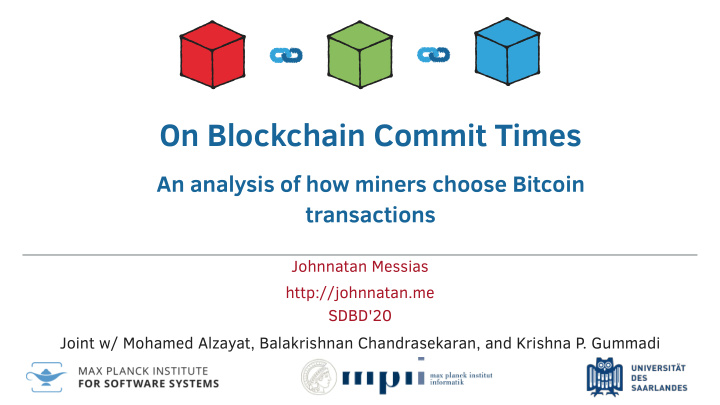



On Blockchain Commit Times An analysis of how miners choose Bitcoin transactions Johnnatan Messias http://johnnatan.me SDBD'20 Joint w/ Mohamed Alzayat, Balakrishnan Chandrasekaran, and Krishna P. Gummadi
1
1
The Current Status of the Top-2 Blockchains Bitcoin Ethereum 60% of all transactions were 80% of all transactions were added added in the last 2.5 years in the last 1.5 years 2
The Current Status of the Top-2 Blockchains Bitcoin Ethereum Could this become a problem in the long term? 60% of all transactions were 80% of all transactions were added added in the last 2.5 years in the last 1.5 years 2
Could This Become a Problem? ‣ The common wisdom: transactions are prioritized based on fee-per-byte ‣ There is no guarantee that it has been followed! ‣ Are miners "fair" on the transaction order? ‣ We want to investigate how miners order transactions! 3
How Transactions Are Selected?
How Transactions Are Selected? Mempool Block limit ... Bob 4
Mining and Rewards ‣ Miners get block reward + transaction fees ‣ Block reward halves every 4 years ‣ In the future, it will become 0! ‣ Fees will be the main mining incentive Block Reward 50 BTC 25 BTC 12.5 BTC 0 BTC ~ 4 years ~ 4 years ~ 121 years 5
What Do Transactions Look Like?
Blockchain Data Set ‣ We deploy a Bitcoin Full-Node ‣ Gather data from Mempool! Data set 힐 Data set 힑 Attributes Feb. 20th – Mar. Jun.1st – 30th, Times span 13th, 2019 2019 #trans. 6,816,375 10,487,966 committed #blocks 3,119 4,522 #empty-blocks 38 18 6
Blockchain Data Set Data set 훢 Data set 훣 7
Is Mempool Congested? ‣ The fear of the ever-growing commit times ‣ Transaction commit times vary! ‣ Mempool is congested in at least 75% , and 92% for data sets 훢 and 훣 , respectively! 8
Do People Pay More When There Is Congestion? ‣ Fee rate increases during periods of congestion. ‣ Transactions fee rate increases proportionally to the level of congestion. 9 Dataset 훢 Dataset 훣
Do High Feerate Transactions Su ff er Fewer Delays? ‣ High fee rate results in decreasing the commit delays! ‣ In both data sets Dataset 훢 Dataset 훣 10
Do Miners Follow the Common Wisdom?
Establishing a Baseline ‣ Actual block: B Miner ‣ Baseline (fee-per-byte ordering): B Baseline B Baseline B Miner Tx 0 Tx 0 Tx 1 Tx 1 Tx 2 Tx 2 Tx 3 Tx 3 11
Establishing a Baseline ‣ Actual block: B Miner ‣ Baseline (fee-per-byte ordering): B Baseline ‣ Miners follow the fee-per-byte ordering ( B Miner ∩ B Baseline = 100 % ) ‣ Do they follow? B Miner ∩ B Baseline Tx 0 Tx 0 Tx 1 Tx 1 Tx 2 Tx 2 Tx 3 Tx 3 11
When "our View" Di ff ers ‣ B Miner Actual block: ‣ Baseline (fee-per-byte ordering): B Baseline ‣ Miners selected the same transactions as in our baseline B Miner ∩ B Baseline ( ) ‣ B Miner ∖ B Baseline Where "our view" is at fault ( ) ‣ Did our node receive the transactions later? ‣ B Baseline ∖ B Miner Where "their view" is at fault ( ) B Baseline B Miner ‣ Did miners receive the transactions later? ‣ We give miners the benefit of doubt! B Miner ∩ B Baseline Tx 0 Tx 0 Tx 2 Tx 4 B Miner ∖ B Baseline B Baseline ∖ B Miner Tx m Tx 3 Tx 1 Tx 1 12
Do Miners Deviate? In the median, 78% of the transactions in Observations are consistent across baselines appear in the corresponding the top-5 mining-pool operators. actual blocks 13
Did Miners Receive the Transactions Later? Even with a 2-block cutoff period, miners ignored some transactions 14
Do Miners Use a Different Protocol? ‣ Transactions in B Miner ∖ B Baseline have lower fee-per-byte compared to those in B Miner ∩ B Baseline ‣ Miners ignore transactions and prioritize others ‣ Perhaps miners are using a different protocol, in addition to the fee-per-byte 15
Do Miners Use a Different Protocol? ‣ Transactions in B Miner ∖ B Baseline have lower fee-per-byte compared to those in B Miner ∩ B Baseline ‣ Miners ignore transactions and prioritize others ‣ Perhaps miners are using a different protocol, in addition to the fee-per-byte Miners somehow deviate! 15
Conclusion
Conclusions and Future Work ‣ Fee-per-byte only does not explain the dequeuing ordering ‣ Users cannot only rely on this metric to offer a proper fee ‣ Mining pool operators behaviors do not make their rank ordering transparent ‣ Can we ensure everyone follows the same prioritization? ‣ Why do miners deviate? ‣ Could it be due to the stratum protocol? ‣ Could it be due to transactions accelerator services? ‣ Apply our methodology on other blockchains (e.g., Ethereum) ‣ Build a predictor to help users with the proper transaction fee 16
On Blockchain Commit Times An analysis of how miners choose Bitcoin transactions Johnnatan Messias http://johnnatan.me SDBD'20 Joint w/ Mohamed Alzayat, Balakrishnan Chandrasekaran, and Krishna P. Gummadi
Recommend
More recommend